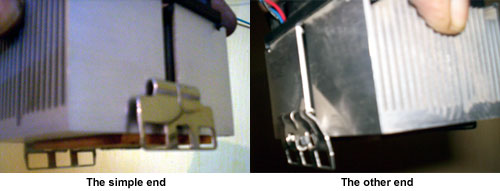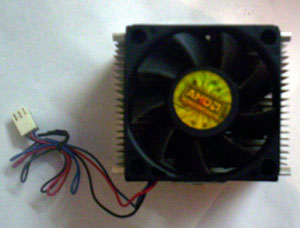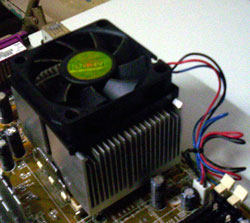The CPUs come bundled with a heatsink and cooling fan as a separate unit. After you have installed the CPU in place on the motherboard don't forget to fasten the heatsink over it.
| Usually the design and fastening mechanism of this unit for the various available processors are different. In this walkthrough we sample the heatsink of an AMD Athlon XP CPU. |
|
The heatsink has thermal interface material stuck to it on the bottom surface. Uncover the heatsink of all packaging and plastic tapes. Do not tamper with the thermal paste.
Place the heatsink on the processor assuring that the retention clip id aligned with the plastic lug on the CPU-socket. Insert one end (the simple end) of the retention clip to the plastic lug on the socket. Then with a flat screw driver slowly push straight-down the other end of the clip and secure the clip to the plastic lug below on the socket.

|
That done, consult your motherboard manual for the location of the three-pin CPU fan header. One should be near the CPU-socket. Plug the fan power chord into that header. |
|
There are many different types of after-market heatsinks available. The basic principle for installing after-market coolers is the same. Some heatsinks may come with a small package of white silicon-based thermal compound which needs to be applied before the heatsink is installed. If this is the case, only use a very small amount, and spread it over the processor's core only. The thermal compound is only used as an interface between the bottom of the heatsink, and the portion of the processor which it comes in contact with.
Some thermal compounds are made with conductive metals to achieve better thermal conductivity between the heatsink and processor. If you decide to try these types of Thermal Interface Materials (TIM), be sure you clean the surface of the processor and base of the heatsink with a soft cloth and Methyl alcohol gently before applying a small amount of the material. Silver-based TIMs are conductive, so do not get them on any electrical components!



